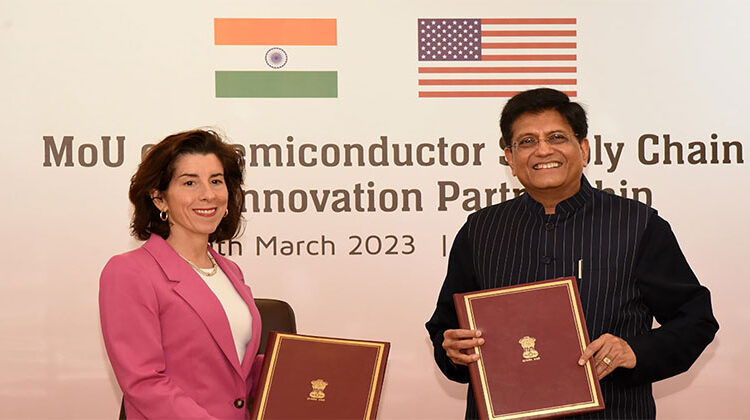
India and the United States (US) are setting new benchmarks in their historic bilateral partnership. This depth of the relationship, focusing on strategy and commerce, is essential to fostering strong cooperation between the two big economies and democracies. This partnership is refining into a nuanced strategic partnership.
India and the US have agreed to set up a Strategic Trade Dialogue. It was decided during the meeting of External Affairs Minister Dr S Jaishankar and US Commerce Secretary Gina Raimondo. It will address export controls, explore ways of enhancing high-technology commerce and facilitate technology transfer between the two countries.
Similarly, US Secretary of Commerce Gina M Raimondo and Union Commerce & Industry minister Piyush Goyal has inked a MoU on a semiconductor Supply Chain and Innovation Partnership following the Commercial Dialogue 2023. This dialogue was re-launched on March 10, 2023, after a gap of three years.
India: Blooming Investment Hub for Semiconductor Industry
India is the ninth most significant trading partner for the US, while the US is India’s largest trading partner and export destination. The bilateral trade in goods saw stellar growth during CY2022, surpassing USD 131 billion in goods, thus doubling since 2014, while total trade in goods and services is expected to cross USD 180 billion. The US is also the third most significant source of foreign direct investment (FDI) for India, and the US is one of India’s top five investment destinations.
The figures here are evidence of the growing economic acknowledgement between the two nations. The US is persuading India to explore its financial abilities with groundbreaking discoveries.
With a complex and massive market, PLI schemes for manufacturing semiconductor chip making, and India is already a semiconductor chip designer, India already has a fundamental semiconductor ecosystem. And today, one of the major players who control the semiconductor industry, the US, is supporting India. This is the most conducive environment for India to make elbow room in this ecosystem.
Both nations have reiterated their commitment towards resilient supply chains. Establishing a collaborative mechanism between the two governments on Semiconductor Supply chain resiliency and diversification. It aligns with US’s CHIPS and Science Act and India’s Semiconductor Mission.
The MOU aims to elevate the complementary strengths of both countries and promote commercial opportunities and the development of semiconductor innovation ecosystems. In addition, the MoU envisages mutually beneficial R&D, talent and skill development. At the end of the commercial dialogue, both sides announced the launch of a new Working Group on Talent, Innovation and Inclusive Growth.
This is a welcoming move to facilitate collaboration on startups, SMEs, skill development and entrepreneurship, including in digital and emergent technologies India’s aspiration to expand its advanced manufacturing is complementary to the US’ goal to make their supply chain more resilient. The US views India as a trusted technology partner. With innovative and significant economic reforms, the Indian economy has drawn much attention worldwide.
The other watershed concurrence of the recent Initiative on Critical and Emerging Technology (iCET) and Indo-Pacific Economic Framework (IPEF) is much discussed bilateral events between the two sides. It has dramatically changed the way this productive engagement is perceived. Both countries have tapped the potential and major determinants of how an interdependent world works: through technology and commerce.
If India plays its move well, then it has the potential to become an integral part of the global supply chain. Semiconductors are the future of the electronic world. Thus, this is a golden opportunity for India has the plausibility to be an entwined player, more than a substitute to China and elaborative as a decisive participant.






